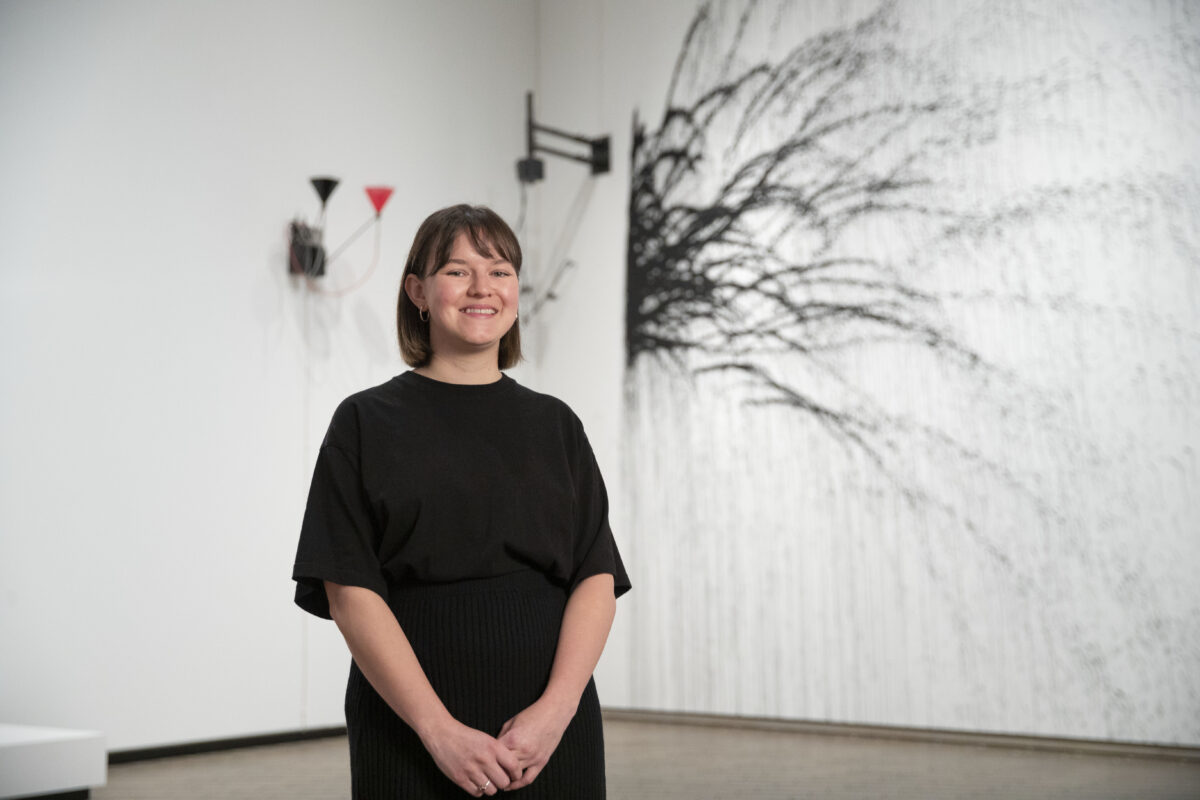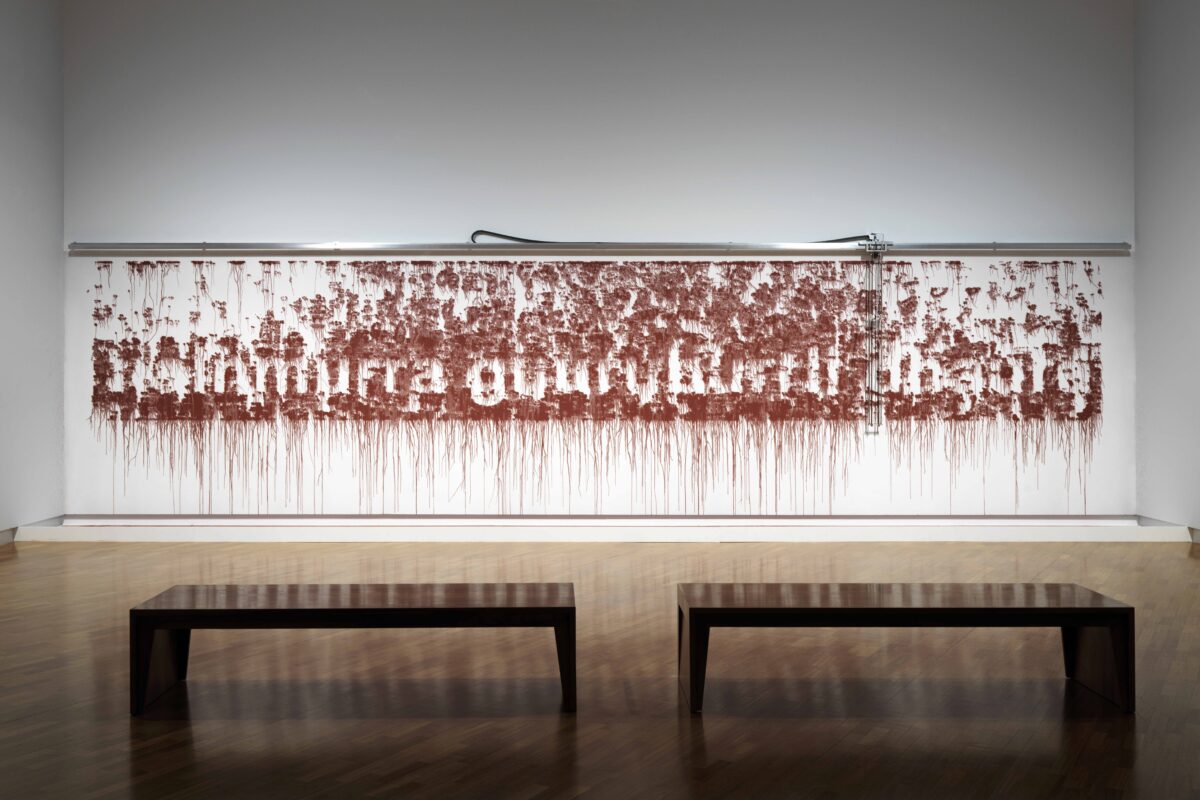
Alysha Redston, Time-Based Media Conservator at the National Gallery of Australia, featuring: Rebecca Horn, Les Amants [The lovers], 1991, National Gallery of Australia, Kamberri/Canberra, purchased 2020 © Rebecca Horn
Could you talk about how you have moved from more traditional areas of specialisation (paintings/objects) to now time-based media?
I completed my Master of Cultural Materials Conservation degree in 2017. Initially I studied as a paintings conservator since I had a background in painting and art history and it felt like the right fit. After a few contracts as a paintings conservator, I picked up a short contract at the National Gallery of Australia (NGA) working with paper conservation on a colour photography migration project. When I began at the NGA the AV collection sat within the paper conservation section, which was my first introduction to this collection. After about a year or so working with paper conservation my contract changed and I found myself working as an objects conservator. I really enjoyed working with the varied materials that objects conservation had to offer, with a particular interest in mechanical and electrical works of art. I remained in objects conservation until 2021 but in the background I was continuing to work with the AV collection. After decades of advocating, the position of Time-Based Media Conservator was made in 2021 under the objects conservation umbrella and I put my name in the hat to be able to focus on this collection.
What does a typical work week look like at the moment? What sorts of objects/projects do you tend to work on?
At the moment my time is divided between collection care and the exhibition schedule. Some of the larger projects in motion are the digitisation of the analogue collection, migrating the digital collection to LTO tape, developing processes and procedures, bringing our digital storage into alignment with preservation standards, and advocating for care of the collection. I also prepare the time-based media collection for display, loan and travelling exhibitions, which can include condition reporting, installing complex artworks, preparing files and liaising with curators, exhibition designers and AV technicians. We recently commissioned a work for Enlighten, which was projected onto the building façade, and I’m currently preparing a travelling exhibition of prominent Australian video artists.
You are the first person to hold this position at the NGA, which must present some interesting challenges in itself, but it is also in a relatively new specialty within the profession—how do you navigate this?
Developing a new position always has its challenges and every collection and institution has unique needs. Since 1982 the Gallery has acquired roughly 400 time-based media artworks spanning film, tape, slides, born-digital video, installations, mechanical and software-based works of art. We also have a large art archive of several thousand artefacts. Throughout that time there have been individuals from curatorial, registration and conservation caring for the time-based media collection alongside their substantive roles. These colleagues are excellent mentors and supervisors who have supported me, provided advice, shared their knowledge and experiences, and have often been a shoulder to cry on or an ear to vent to.
Time-based media is a newly developed stream in conservation, but in Australia we have a small and devoted network of colleagues working with these collections both in dedicated positions and in associated positions. The experiences shared in these networks has helped me greatly in thinking about the collection at NGA and developing preservation and conservation plans.
Are you in conversation with international colleagues, where time-based media conservation is perhaps better established? Is there anything about the Australian context that means you have to adapt your approach?
The international time-based media community holds a wealth of knowledge, and the generosity of time given in workshops, conferences, panel discussions and mentorship has also greatly influenced my direction with the time-based media collection. A particularly pivotal workshop for me was the MoMA Workshop: Conservation of Video Art funded by the Andrew W Mellon Foundation. This workshop gave me some crucial tools that really helped shape the processes I wanted to put in place. I’ve also attended many time-based media lectures, workshops and conferences hosted by the NYU Conservation Center that have been fantastic. All institutions have different collections, histories, resourcing, and politics that play into decision making, but I’ve been able to draw from these workshops and shape the approach to suit the NGA.
Do you have a favourite object or collection that you have worked on? Or do you have a favourite type of treatment/activity you like to work on?
The time-based media collection at the NGA is very impressive (I may be slightly biased though), and sometimes I’ll come across a work I’ve never seen before and it’ll sweep me off my feet. A few of my favourite video artists include Tracey Moffatt, Shaun Gladwell, Cheryl Donegan, Daniel Crooks, Julie Rrap and Vernon Ahh Kee. A highlight moment has been working on Robert Andrew’s A connective reveal: nainmurra guuruburrii dhaura and over the course of a few years we have developed a strong conservation and preservation plan with the artist’s input and have successfully toured this work. Another highlight has been installing Rebecca Horn’s Les Amants [The Lovers]. The installation of this work was a lengthy process of test installs, but it was a privilege to work on such a prominent artwork. I quite enjoy problem solving complex works of art, where technology, software and art intersect.

Robert Andrew, Yawuru people, A connective reveal—nainmurra guuruburrii dhaura, 2022, installation view, 4thNational Indigenous Art Triennial: Ceremony, National Gallery of Australia, Kamberri/Canberra, 2022, created in consultation with Dr Matilda House and Paul Girrawah House, Ngambri-Ngunnawal Traditional Custodians, purchased 2021 in celebration of the National Gallery of Australia’s 40th anniversary, 2022 © the artist
The e-News has a large student readership—anything you would like to share with students as an early career conservator in regard to establishing a place within the profession?
In reflecting on my own fragmented journey that has led to this job, I think it’s important to gravitate towards what sparks your interest. There are so many hidden paths in this profession that sometimes taking a step into something different that interests you can open doors that you may not have seen before.
Anything else you’d like to share with the conservation community?
I would like to thank the conservation community, in particular time-based media colleagues, for being so welcoming and generous with their knowledge and experience. I would also like to thank NGA conservation colleagues Debbie Ward, Fiona Kemp and Sarah McHugh for their ongoing support and mentorship over the past five years.